DNA Damage in Nijmegen Breakage Syndrome Cells Leads to PARP Hyperactivation and Increased Oxidative Stress
Nijmegen Breakage Syndrome (NBS), an autosomal recessive genetic instability syndrome, is caused by hypomorphic mutation of the NBN gene, which codes for the protein nibrin. Nibrin is an integral member of the MRE11/RAD50/NBN (MRN) complex essential for processing DNA double-strand breaks. Cardinal features of NBS are immunodeficiency and an extremely high incidence of hematological malignancies. Recent studies in conditional null mutant mice have indicated disturbances in redox homeostasis due to impaired DSB processing. Clearly this could contribute to DNA damage, chromosomal instability, and cancer occurrence. Here we show, in the complete absence of nibrin in null mutant mouse cells, high levels of reactive oxygen species several hours after exposure to a mutagen. We show further that NBS patient cells, which unlike mouse null mutant cells have a truncated nibrin protein, also have high levels of reactive oxygen after DNA damage and that this increased oxidative stress is caused by depletion of NAD+ due to hyperactivation of the strand-break sensor, Poly(ADP-ribose) polymerase. Both hyperactivation of Poly(ADP-ribose) polymerase and increased ROS levels were reversed by use of a specific Poly(ADP-ribose) polymerase inhibitor. The extremely high incidence of malignancy among NBS patients is the result of the combination of a primary DSB repair deficiency with secondary oxidative DNA damage.
Published in the journal:
. PLoS Genet 8(3): e32767. doi:10.1371/journal.pgen.1002557
Category:
Research Article
doi:
https://doi.org/10.1371/journal.pgen.1002557
Summary
Nijmegen Breakage Syndrome (NBS), an autosomal recessive genetic instability syndrome, is caused by hypomorphic mutation of the NBN gene, which codes for the protein nibrin. Nibrin is an integral member of the MRE11/RAD50/NBN (MRN) complex essential for processing DNA double-strand breaks. Cardinal features of NBS are immunodeficiency and an extremely high incidence of hematological malignancies. Recent studies in conditional null mutant mice have indicated disturbances in redox homeostasis due to impaired DSB processing. Clearly this could contribute to DNA damage, chromosomal instability, and cancer occurrence. Here we show, in the complete absence of nibrin in null mutant mouse cells, high levels of reactive oxygen species several hours after exposure to a mutagen. We show further that NBS patient cells, which unlike mouse null mutant cells have a truncated nibrin protein, also have high levels of reactive oxygen after DNA damage and that this increased oxidative stress is caused by depletion of NAD+ due to hyperactivation of the strand-break sensor, Poly(ADP-ribose) polymerase. Both hyperactivation of Poly(ADP-ribose) polymerase and increased ROS levels were reversed by use of a specific Poly(ADP-ribose) polymerase inhibitor. The extremely high incidence of malignancy among NBS patients is the result of the combination of a primary DSB repair deficiency with secondary oxidative DNA damage.
Introduction
Genetic cancer susceptibility disorders, such as Xeroderma pigmentosum and Fanconi anemia, generally have deficiencies in DNA repair and cell cycle regulation leading to tumour initiation. The specific mutagen sensitivities underlying these disorders define a set of enzymes and pathways involved in the DNA damage response. Nevertheless, these pathways clearly overlap and components in one pathway can be critically involved in another. For example, the nucleotide excision repair pathway mutated in Xeroderma pigmentosum is also required for the repair of interstrand crosslinks, to which Fanconi anemia patient cells are particularly sensitive [1].
Nijmegen Breakage Syndrome (NBS), Nijmegen Breakage Syndrome like disorder (NBSLD), Ataxia telangiectasia (AT) and Ataxia telangiectasia like disorder (ATLD) are clinically and biologically overlapping entities. Whilst the underlying proteins are intimately associated, cancer predisposition is a major life threatening feature of NBS and AT only. The proteins mutated in these four disorders are all involved in the sensing and repair of DNA double-strand breaks (DSB). However, if, as seems likely, the mutation rate in patient cells is increased, this may not be solely due to the primary DNA lesion but, rather, to the cumulative effects of auxiliary cellular disturbances. Thus it has been repeatedly shown that AT patient cells and knockout mice have increased oxidative stress [2]–[4] which could contribute to clinical progression of the disease.
Oxidative stress has not previously been associated with NBS, however, our previous proteomic study of null mutant mice suggested disturbances in the redox homeostasis in the livers of irradiated mice [5]. We speculated that this could be due to hyperactivation of members of the Poly(ADP-ribose) polymerase (PARP) family, such as PARP-1, PARP-2 and PARP-3 which rapidly detect DNA strand breaks and regulate/modulate proteins required for an effective cellular response. In cells unable to repair DSBs, the permanent activation or even hyperactivation of PARP enzymes was expected to disturb cellular function and contribute to an increased mutation rate. Interestingly, poly(ADP-ribosyl)ation was reported to be unaffected in both AT patient cells and knock out mouse cells [6]. In view of the close relationship between NBS and AT we sought to examine the situation in NBS. For these investigations we have started with our null mutant mouse cells since, unlike patient cells, they provide a system with complete absence of the affected protein, nibrin.
We find greatly increased levels of reactive oxygen species in both null mutant mouse cells and NBS patient cells after a DNA damaging exposure. Unlike AT cells, we find a parallel increase in the activity of PARP enzymes as measured by examining poly(ADP-ribosyl)ation of proteins. As we have previously hypothesized, depletion of the cellular NAD+ pool accompanies excessive poly(ADP-ribosyl)ation in NBS cells and this severely compromises the anti-oxidant capacity of the cells. Thus the extremely high incidence of hematological malignancies in NBS may be the result of the combination of a primary DSB repair deficiency and accompanying oxidative damage.
Results
Increased reactive oxygen species after DNA damage in Nbn null mutant murine fibroblasts and NBS patient cells
The murine fibroblasts used in these experiments have a neomycin insertion in one Nbn allele (Nbnins-6), a null mutation, and loxP sites flanking exon six in the other Nbn allele (Nbnlox-6). Treatment of these cells with cre recombinase leads to cells with biallelic Nbnins-6/del6 null mutations [7]. Henceforth we refer to wild type alleles and alleles with exon 6 flanked by loxP sites as Nbn+ and the null mutant Nbnins-6 and Nbndel-6 alleles as Nbn−. As shown in Figure 1A, 12 hours after introduction of DSBs there is a particularly high level of ROS in fibroblasts completely lacking nibrin due to null mutation of the Nbn gene (Figure 1B). The cells were treated here with 10 µg/ml bleomycin, which is equivalent to irradiation with 2 Gy irradiation causing approximately 60 DSBs per cell, with a ratio of DSBs to single-strand breaks of 1∶9 [8], [9]. As the non-fluorescent compound, CM-H2DCFDA, is converted to fluorescein specifically by hydrogen peroxide, hydroxyl radicals, peroxynitrite anion and peroxyl radicals, the observed over two-fold increase in fluorescence intensity in comparison to heterozygous cells is therefore due to the accumulation of these species [10]–[12]. These radicals are short lived with half-lives of just seconds or less [13], [14]. Therefore, their high concentration 12 hours after treatment with bleomycin suggests that they are being permanently produced in the Nbn−/− cell, presumably as a consequence of its unrepaired DSBs.
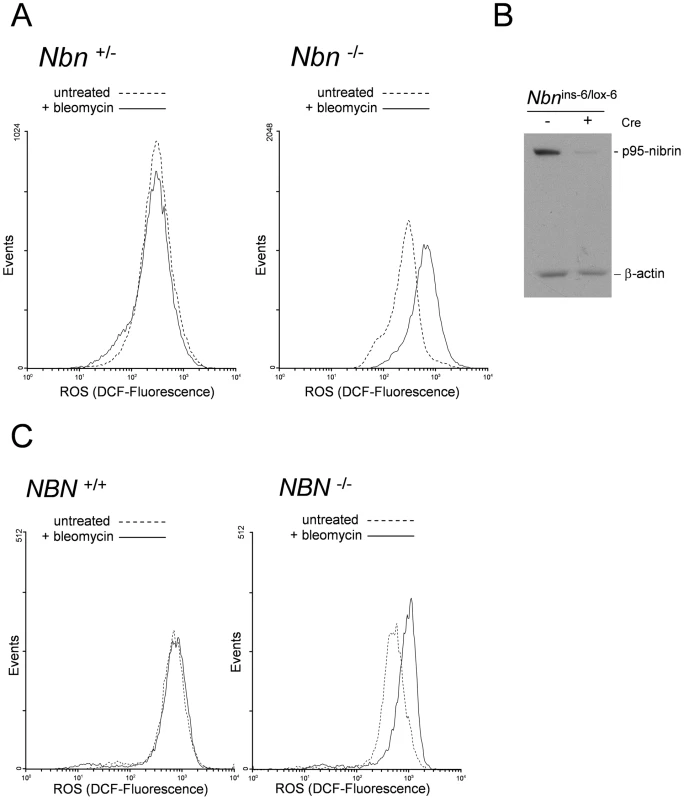
The null mutant murine cells examined here are particularly useful since they allow examination of cellular responses in the complete absence of nibrin, a situation not naturally available for human cells. Having seen the importance of full length nibrin for maintenance of cellular redox homeostasis by timely repair of DSBs, we turned to NBS patient cells, in which a truncated and partially functional nibrin fragment, p70-nibrin, is present [15], [16]. As shown in Figure 1C, fibroblasts from NBS patients also show an increased level of ROS after DNA damage. The increase in ROS-induced fluorescence, 1.5(+/−0.27) times that of controls, is less than in the complete absence of nibrin, 2.33(+/−0.9) times, which might indicate partial repair of DSBs or simply reflect differences in murine and human cells in ROS induction.
The results of repeated measurements of ROS levels in Nbn null mutant and NBS patient cells are shown in Figure 2. As indicated in the figure, the differences in ROS levels in comparison to wild type cells after DNA damage are statistically significant in the non-parametric two-tailed Mann-Whitney test.
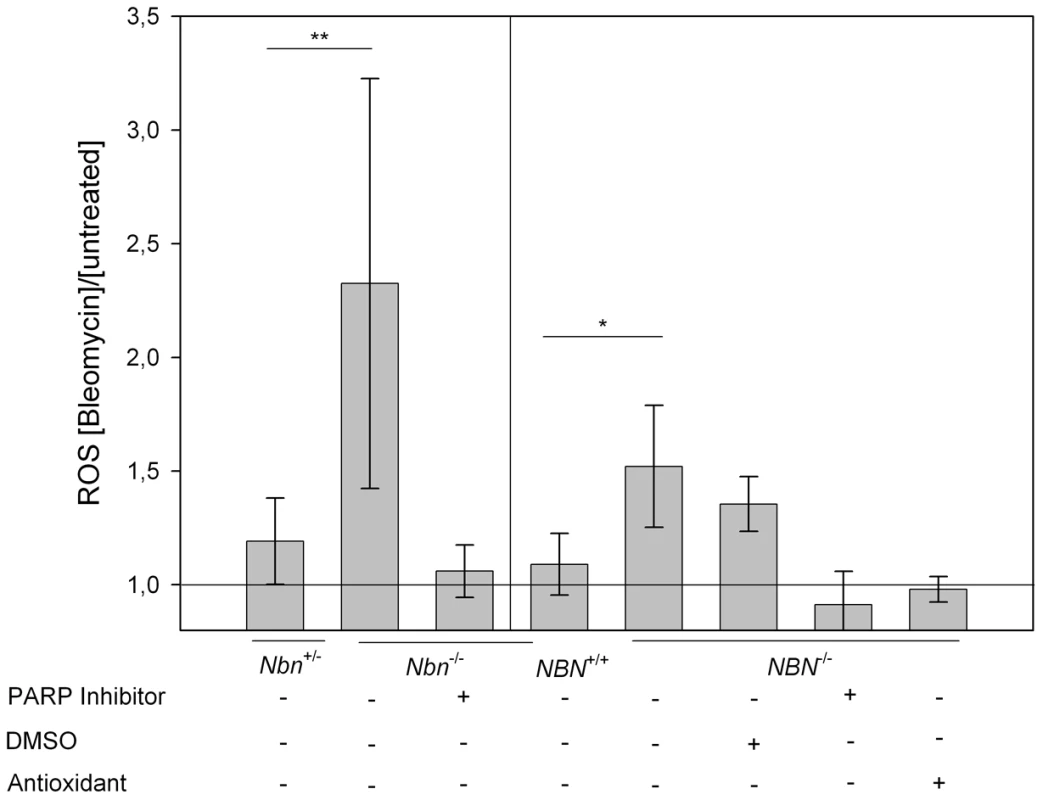
Hyperactivation of Poly(ADP-ribose) polymerases in the absence of full-length nibrin
We have argued previously that the permanent production of ROS in the absence of nibrin is caused by rapid depletion of NAD+ due to hyperactivation of Poly(ADP-ribose) polymerases and consequent loss of cellular antioxidant capacity [5]. In order to test this hypothesis, we treated cells heterozygous and homozygous for Nbn null mutations with bleomycin to induce DSBs and examined the extent and kinetics of poly(ADP-ribosyl)ation by western blot. As shown in Figure 3A, there is rapid and sustained poly(ADP-ribosyl)ation of proteins in the absence of nibrin under conditions in which PARP enzyme activity in heterozygous cells cannot be detected.
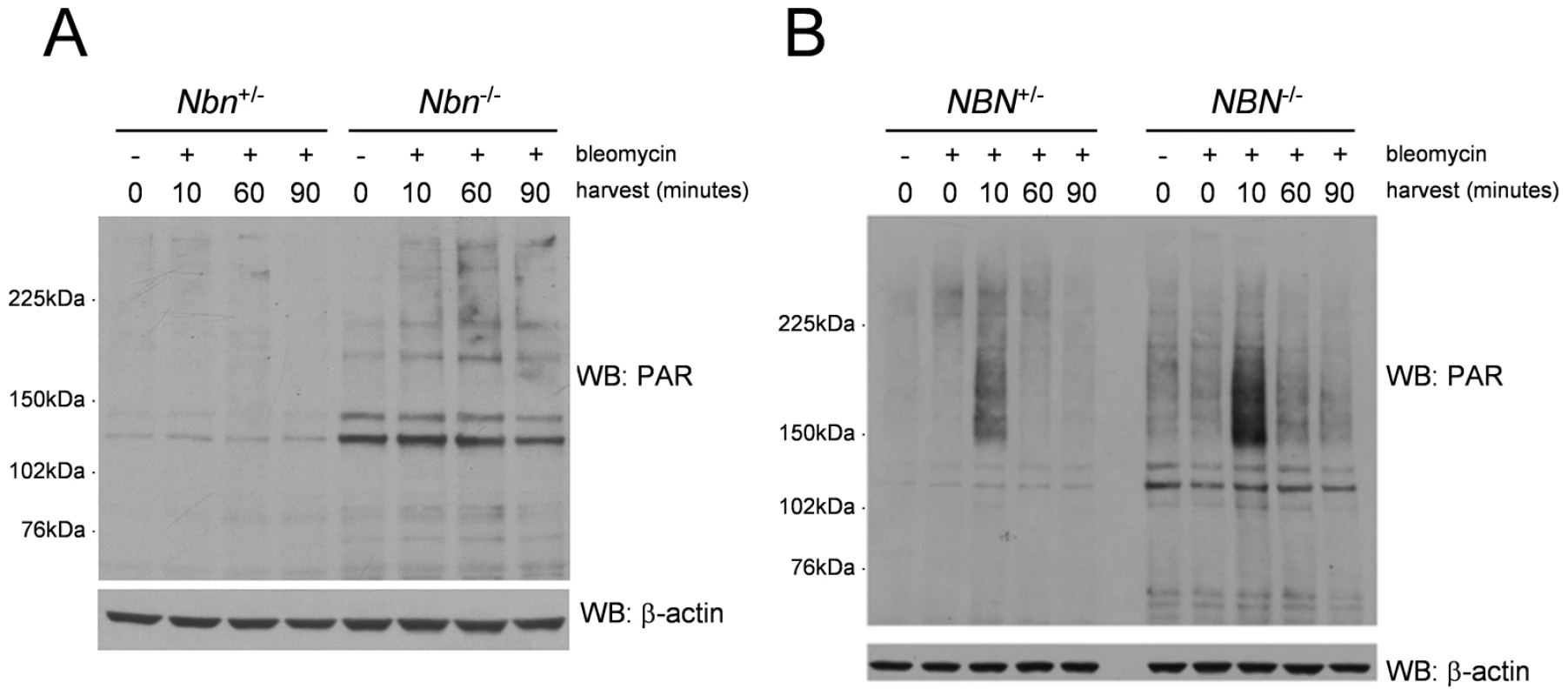
In Figure 3B PARP activity is shown for control fibroblasts and fibroblasts from NBS patients. Even in these cells with a partially active nibrin fragment, there is rapid and extensive activation of PARP as evidenced by poly(ADP-ribosyl)ation of proteins. By densitometric analysis of three independent blots we found a 3-fold increase in PAR-modified proteins in control fibroblasts 10 minutes after a DNA damaging treatment and a 17-fold increase in NBS patient fibroblasts (p = 0.05). Levels of protein poly(ADP-ribosyl)ation have returned to near normal 12 hours after treatment (data not shown).
We reasoned that if the increased ROS levels in NBS patient cells are a consequence of increased PARP activity, rather than its cause, inhibition of the enzyme should reduce ROS levels, whilst scavenging of ROS should not affect PARP activity. As shown in Figure 4, scavenging ROS using the antioxidant vitamin E derivative TROLOX reduced ROS levels in damaged NBS patient cells to the same levels as in untreated cells (Figure 4A and Figure 2). However, although cells treated with TROLOX and bleomycin were essentially ROS free, PARP activity remained high (Figure 4B). Inhibition of PARP-1, PARP-2 and PARP-3 with the specific inhibitor KU-0058948 [17], on the other hand (Figure 4B), did reduce ROS levels to normal (Figure 2).
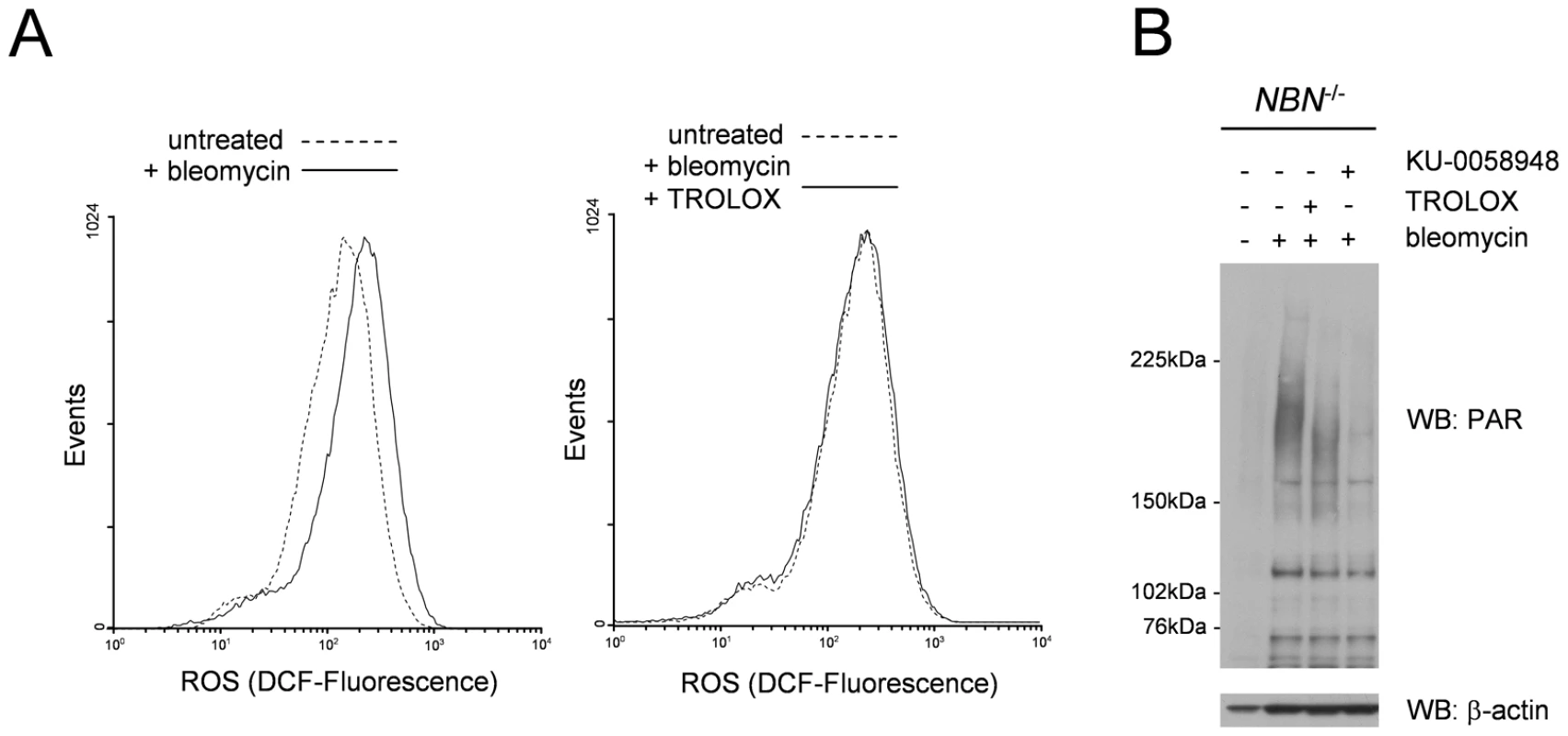
Rapid depletion of NAD+ in NBS patient cells after DNA damage
The link between ROS levels and PARP enzyme activity is the latter's requirement for NAD+, an important component of the cells antioxidant capacity. Indeed, numerous reports have shown that PARP inhibition prevents the reduction of NAD+ concentrations in cells subject to genotoxins, with a resulting decrease in cellular necrosis [18], [19]. As shown in Figure 5, we measured NAD+ levels in NBS fibroblasts after a bleomycin treatment in comparison to normal fibroblasts. There is very rapid depletion of NAD+ in the patient cells in comparison to the control cells, confirming the hyperactivation of PARP in these cells. Interestingly, the baseline levels of NAD+ in these NBS patient cells were considerably higher than in controls (1,850(+/−86) vs. 875(+/−15) pmol/106 cells) suggesting that even in the absence of exogenous damaging agents, NAD+ requirements are higher in these repair deficient cells. In line with this observation we note that PARP activity in undamaged NBS cells is apparently higher than in controls (Figure 3B). Even 12 hours after treatment with bleomycin, baseline levels of NAD+ have still not been reached in NBS cells, in agreement with the timing of ROS measurements shown in Figure 1 and Figure 2.
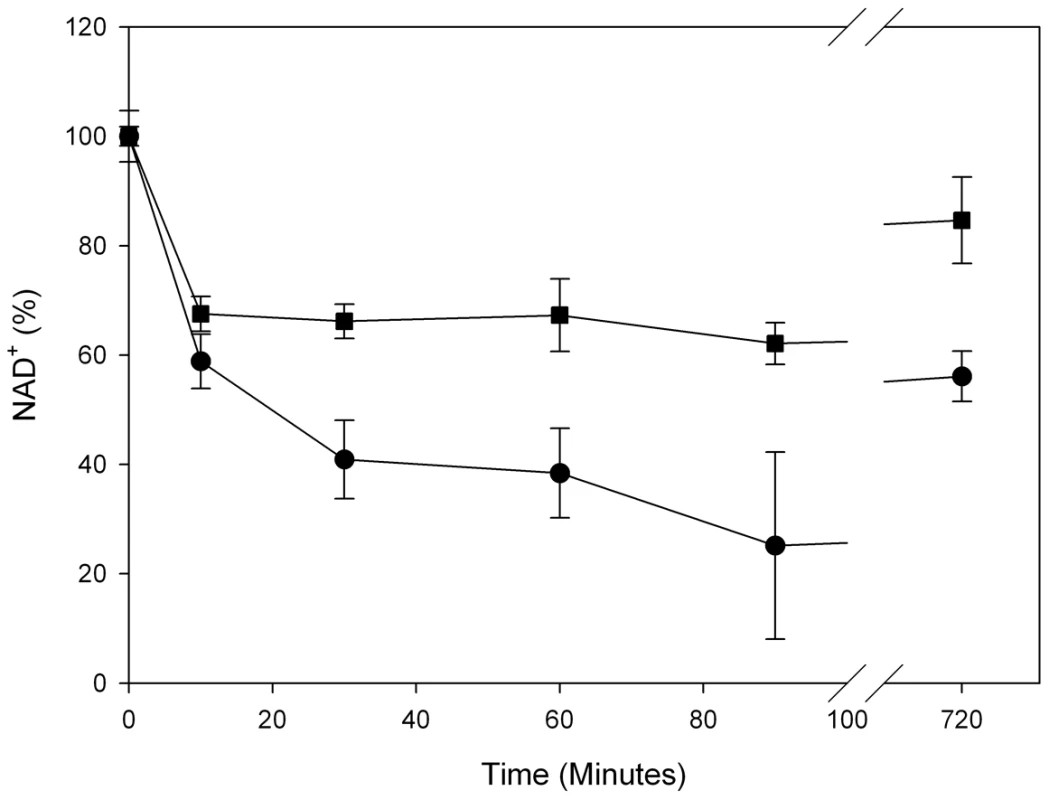
Discussion
Nibrin is a component of the trimeric MRN complex together with Mre11 and RAD50. This complex is involved in the processing of all DNA double-strand breaks in the cell, whatever their origin: mutagen exposure, physiological processes or simply chromosome ends [20]. The complex is implicated in DSB repair by both non-homologous end joining and homologous recombination [21], [22]. As a sensor of DSBs the MRN complex is involved in the activation of ATM and subsequent downstream targets to induce cell cycle checkpoints [23]. Telomeres, the ends of chromosomes, are maintained by a mechanism in which the MRN complex has also been implicated [24].
Cancer incidence in Nijmegen Breakage Syndrome is extremely high with 40% of patients developing a tumor, mostly lymphoma, before the age of 20 [25], [26]. This contrasts with the related disorder AT in which lifetime cancer risk is 20–30% [27], [28]. For accurate prognosis and improved patient care it is important to establish which factors contribute to this cancer predisposition. In this respect, the role of nibrin in both DNA repair and cell cycle regulation may be significant. It has been shown that mutation of Nbn in mouse models leads to a defect in apoptosis [29], [30], [31] and reduced clearance of damaged cells could clearly contribute to the high cancer incidence [32]. In addition, factors leading to an increased mutation rate, beyond that of the primary double strand break, could be present in NBS. Previous work has suggested that oxidative stress could be one such factor [5].
Unphysiologically high levels of ROS are a hallmark of oxidative stress and can be directly due to mutagenic agents, such as ionizing radiation, or, rather, reflect overburden of the cellular antioxidation mechanisms. These mechanisms can be either direct scavenging of radicals or regeneration of oxidized biomolecules [33]. NADPH and NADH have been reported to be involved in both kinds of antioxidant activity [34]. Thus, reduction in the availability of these essential cellular antioxidants leads inevitably to increased cellular ROS levels and oxidative stress, even in the absence of DNA damage. The radicals detected in this report, peroxynitrite anion, hydroxyl and peroxyl radicals or their metabolites, all react aggressively with DNA to yield oxidized bases and single strand breaks. An increased mutation rate would be the consequence. In lymphocytes, in which DSBs are a prerequisite for immunoglobulin gene rearrangements, their non-repair due to the absence of nibrin could thus lead to redox disturbances and an even higher occurrence of mutations.
NAD+ is the precursor for NAD(P)H and its cellular level is therefore critical for cellular redox homeostasis. NAD+ is also a substrate for the PARP superfamily of enzymes with a common catalytic activity and involved in the DNA damage response [35], [36]. For example, PARP-1 is a nuclear DNA damage sensor and binds to persisting single - and double-strand breaks [37]. PARP enzymes covalently attach ADP-ribose to glutamate, aspartate, and lysine residues of acceptor proteins. Branched ADP-ribose polymers are formed at nuclear acceptor proteins that facilitate DNA repair through modifying and activating structural proteins and enzymes such as histone H2AX, topoisomerase I and II, DNA polymerase α and β, DNA ligase I and II, nuclear factor (NF)-κB, and p53. Hyperactivation of PARP has been frequently described in various systems leading to depletion of the NAD+ pool [38]–[40]. It has also been suggested as a contributing factor in AT [41]. The unrepaired DSBs in Nbn null mutant cells clearly lead to such PARP hyperactivation, as shown here. As previously reported, the Nbn−/− cells attempt to combat the increased ROS levels due to NAD+ depletion by upregulating genes involved in the detoxification of radicals, such as MnSOD. In contrast, enzymes also requiring the NAD+ substrate were downregulated, for example, glyoxylate reductase 6.7-fold [5].
In Nbn−/− cells and also in NBS patient cells, the loss of full nibrin function leads to a delay in the activation of ATM [42]. It has recently been shown that ATM, in addition to its direct role in the DNA damage response, also promotes the pentose phosphate pathway leading to increased NADPH levels and thus improving anti-oxidant defence [43]. In the absence of nibrin, promotion of the pentose phosphate pathway will not occur, indeed in our proteomics analysis of irradiated Nbn−/− mouse livers, transaldolase, a key enzyme of the pentose phosphate pathway, was actually reduced 6-fold [5].
Human cells with null mutation of the NBN gene are non-viable and NBS patients all have hypomorphic mutations and express a truncated nibrin protein [15], [44]. In the case of the major founder mutation, c.657_661del5 (p.K219fsX19), the truncated protein, p70-nibrin, is translated from an upstream start codon brought into frame by the deletion [15]. These proteins clearly have enough partial activity to ensure survival [7], [45], but are severely compromised in the DNA damage response. This is manifest as the increased chromosome breakage, characteristic translocations, radiosensitivity, immunodeficiency and cancer predisposition characteristic of NBS [25]. These partially active proteins all have the carboxy terminal MRE11 and ATM interacting domains but lack the FHA and first BRCT domains of the amino-terminus, which are required for interaction with proteins such as gamma-H2AX, MDC1 and p53BP1 [46], [47], [48].
Here we describe increased ROS levels after DNA damage in NBS patient cells. The truncated p70-nibrin is clearly unable to fully prevent the hyperactivation of PARP, NAD+ depletion and ROS generation. Patient cells showed approximately 1.5 times the level of ROS after DNA damage in comparison to control cells whilst in null mutant mouse cells the levels were more than two fold increased. We have previously described individual variations in the level of p70-nibrin expression [16] which are due to differences in its proteasomal degradation [49]. Low levels of p70-nibrin correlate with cancer incidence and it can be speculated that a contributing factor may be higher oxidative stress.
In conclusion we present evidence for a further detrimental consequence of NBN mutation. In addition to a DSB repair deficiency and failure in cell cycle checkpoints, lack of fully functional nibrin results in increased ROS levels and oxidative stress. This unique combination would lead to an extremely high mutation rate in cells with an underlying apoptosis deficiency. Oncogene activation and tumour initiation are the consequence.
Materials and Methods
Cell culture, cre recombinase, and mutagen treatment
Spontaneous transformed murine fibroblasts were grown from ear explants of Nbnlox-6/ins-6 mice [7]. Cells were cultured in Dulbecco's modified Eagle's medium (DMEM; Gibco, Life technologies) supplemented with 5% glucose (glc) and 10% fetal calf serum (FCS) strictly in the absence of antibiotics. Cell culture conditions were 37°C and 5% CO2. Environmental oxygen was reduced to 10%. Cells were split 1∶10 at least twice a week.
The immortalized human NBS cell lines GM7166VA7 and NBS-1LBI homozygous for NBN657del5/657del5 and a control cell line, LN9, transformed with simian virus 40 (SV40) were cultured using the same conditions described above.
The cre recombinase fusion protein, HTNC [50], was isolated as previously described [7]. Exponentially growing cells were incubated in 2 µM HTNC twice for 6 hours in a 48 hour period. Knock-down efficiency was verified by western blot analysis using a polyclonal rabbit antibody to detect murine nibrin (Pineda Antikörper-Service, Berlin). Murine polyclonal antibody against β-actin served as a loading control (Abcam).
DNA damage was induced by incubating cells for two hours in the radiomimetic drug bleomycin at 10 µg/ml. Cells were then washed with medium and returned to culture for the specified times.
PAR detection and Western blot
Cells were scraped into ice-cold PBS, pelleted and snap frozen in liquid nitrogen. Cell pellets were stored at −80°C. For analysis, pellets were solubilised in LDS-sample buffer (Invitrogen) and sonified for 60 seconds using a model 450 sonifier (Branson, Emerson Industrial Automation). Proteins were separated on Tris-Acetate gels (3–8%) and transferred to PVDF membranes (Hybond-P, GE Healthcare).
To detect poly(ADP-ribosyl)ated proteins, two different polyclonal antibodies (Abcam) each producing the characteristic smear of PAR modified proteins were used. As a loading control β-actin was detected using a murine polyclonal antibody. Blots were repeated three times using independent lysates. For densitometry, films were scanned using the ScanMaker scanner (Mikrotek) and lanes quantified using ImageQuant software (Molecular Dynamics).
PARP inhibition and ROS scavenging
The PARP inhibitor KU-0058948 was kindly provided by KuDOS Pharmaceuticals Ltd. (AstraZeneca PLC). The compound was dissolved in 100% dimethylsulfoxid (DMSO) and stored at −20°C. Cells were treated with 1 µM inhibitor in medium containing 0.5% DMSO for 10 hours before induction of DNA damage and then for a further 12 hours. Control cells were incubated in parallel in medium containing 0.5% DMSO.
In some experiments, ROS were scavenged by treating cells with the antioxidant vitamin E derivative, 6-hydroxy-2,5,7,8-tetramethylchroman-2-carboxylic acid (TROLOX, Hoffman-La Roche). Cells were incubated in 500 µM TROLOX for 12 hours after the bleomycin damaging treatment.
Quantification of intracellular reactive oxygen species
The amount of intracellular ROS was monitored before and after the induction of DNA damage in fibroblasts at 50% confluence. Cells were washed and harvested into PBS and 106 cells were stained in 500 µl PBS with 10 mM 5-(and-6)-chloromethyl-29,79-dichlorodihydrofluorescein diacetate (CM-H2DCFDA; Invitrogen) for 20 min at 37°C in the dark. Samples were subsequently washed using ice-cold PBS and centrifuged for 10 min at 1000 rpm (∼180×g) before being resuspended in FACS dissociation solution (FACSmax, Genlantis) and kept on ice until analysis. Flowcytometry was performed using the FACS-Calibur (Becton Dickinson Bioscience) counting a minimum of 104 cells per sample. The opensource flowcytometry software WinMDI V2.9 was used for data analysis. Gates were placed on dot blots of forward vs. side scatter to exclude apoptotic cells and debris from the fluorescence histograms shown in the figure. In all measurements at least 85% of cells were within this gate. All experiments were repeated independently at least three times. Relative ROS-levels are expressed as [gated mean of bleomycin treated cells]/[gated mean of untreated cells] and were evaluated for statistical significance using the non parametric two-tailed Mann-Whitney U test.
Quantification of NAD+ levels in fibroblasts
NBS patient fibroblasts and control fibroblasts were treated in triplicate with bleomycin as indicated above. At the timepoints indicated in Figure 5 cells were precipitated with 0.5 M perchloric acid on ice. After 15 min samples were centrifuged at 1500×g for 10 min and the supernatant (500 µl) was combined with 350 µl of 1 M KOH, 0.33 M K2HP04, 0.33 M KH2P04 followed by incubation on ice for 15 min.
Cells were centrifuged at 1500×g for 10 min and the supernatant was frozen at −20°C before NAD+ determination by using an enzymatic cycling assay [51].
Zdroje
1. WangCLambertMW 2010 The Fanconi anemia protein, FANCG, binds to the ERCC1-XPF endonuclease via its tetratricopeptide repeats and the central domain of ERCC1. Biochemistry 49 5560 5569
2. BarlowCDenneryPAShigenagaMKSmithMAMorrowJD 1999 Loss of the ataxia-telangiectasia gene product causes oxidative damage in target organs. Proc Natl Acad Sci U S A 96 9915 9919
3. KamslerADailyDHochmanASternNShilohY 2001 Increased oxidative stress in ataxia telangiectasia evidenced by alterations in redox state of brains from Atm-deficient mice. Cancer Res 61 1849 1854
4. ZivSBrennerOAmariglioNSmorodinskyNIGalronR 2005 Impaired genomic stability and increased oxidative stress exacerbate different features of Ataxia-telangiectasia. Hum Mol Genet 14 2929 2943
5. MelchersAStocklLRadszewskiJAndersMKrenzlinH 2009 A systematic proteomic study of irradiated DNA repair deficient Nbn-mice. PLoS ONE 4 e5423 doi:10.1371/journal.pone.0005423
6. DantzerFMenissier-de MurciaJBarlowCWynshaw-BorisAde MurciaG 1999 Poly(ADP-ribose) polymerase activity is not affected in ataxia telangiectasia cells and knockout mice. Carcinogenesis 20 177 180
7. DemuthIFrappartPOHildebrandGMelchersALobitzS 2004 An inducible null mutant murine model of Nijmegen breakage syndrome proves the essential function of NBS1 in chromosomal stability and cell viability. Hum Mol Genet 13 2385 2397
8. CedervallBWongRAlbrightNDynlachtJLambinP 1995 Methods for the quantification of DNA double-strand breaks determined from the distribution of DNA fragment sizes measured by pulsed-field gel electrophoresis. Radiat Res 143 8 16
9. AdemaADCloosJVerheijenRHBraakhuisBJBryantPE 2003 Comparison of bleomycin and radiation in the G2 assay of chromatid breaks. Int J Radiat Biol 79 655 661
10. BrandtRKestonAS 1965 Synthesis of Diacetyldichlorofluorescin: a Stable Reagent for Fluorometric Analysis. Anal Biochem 11 6 9
11. KestonASBrandtR 1965 The Fluorometric Analysis of Ultramicro Quantities of Hydrogen Peroxide. Anal Biochem 11 1 5
12. CathcartRSchwiersEAmesBN 1983 Detection of picomole levels of hydroperoxides using a fluorescent dichlorofluorescein assay. Anal Biochem 134 111 116
13. MillerDMBuettnerGRAustSD 1990 Transition metals as catalysts of “autoxidation” reactions. Free Radic Biol Med 8 95 108
14. ValkoMIzakovicMMazurMRhodesCJTelserJ 2004 Role of oxygen radicals in DNA damage and cancer incidence. Mol Cell Biochem 266 37 56
15. MaserRSZinkelRPetriniJH 2001 An alternative mode of translation permits production of a variant NBS1 protein from the common Nijmegen breakage syndrome allele. Nat Genet 27 417 421
16. KrugerLDemuthINeitzelHVaronRSperlingK 2007 Cancer incidence in Nijmegen breakage syndrome is modulated by the amount of a variant NBS protein. Carcinogenesis 28 107 111
17. FarmerHMcCabeNLordCJTuttANJohnsonDA 2005 Targeting the DNA repair defect in BRCA mutant cells as a therapeutic strategy. Nature 434 917 921
18. BelenkyPBoganKLBrennerC 2007 NAD+ metabolism in health and disease. Trends Biochem Sci 32 12 19
19. YangTSauveAA 2006 NAD metabolism and sirtuins: metabolic regulation of protein deacetylation in stress and toxicity. Aaps J 8 E632 643
20. DemuthIDigweedM 2007 The clinical manifestation of a defective response to DNA double-strand breaks as exemplified by Nijmegen breakage syndrome. Oncogene 26 7792 7798
21. KrackerSBergmannYDemuthIFrappartPOHildebrandG 2005 Nibrin functions in Ig class-switch recombination. Proc Natl Acad Sci U S A 102 1584 1589
22. YangYGSaidiAFrappartPOMinWBarrucandC 2006 Conditional deletion of Nbs1 in murine cells reveals its role in branching repair pathways of DNA double-strand breaks. Embo J 25 5527 5538
23. LeeJHPaullTT 2004 Direct activation of the ATM protein kinase by the Mre11/Rad50/Nbs1 complex. Science 304 93 96
24. CabuyENewtonCJoksicGWoodbineLKollerB 2005 Accelerated telomere shortening and telomere abnormalities in radiosensitive cell lines. Radiat Res 164 53 62
25. 2000 Nijmegen breakage syndrome. The International Nijmegen Breakage Syndrome Study Group. Arch Dis Child 82 400 406
26. ChrzanowskaKHKleijerWJKrajewska-WalasekMBialeckaMGutkowskaA 1995 Eleven Polish patients with microcephaly, immunodeficiency, and chromosomal instability: the Nijmegen breakage syndrome. Am J Med Genet 57 462 471
27. SwiftMSholmanLPerryMChaseC 1976 Malignant neoplasms in the families of patients with ataxia-telangiectasia. Cancer Res 36 209 215
28. TaylorAM 2001 Chromosome instability syndromes. Best Pract Res Clin Haematol 14 631 644
29. DifilippantonioSCelesteAKruhlakMJLeeYDifilippantonioMJ 2007 Distinct domains in Nbs1 regulate irradiation-induced checkpoints and apoptosis. J Exp Med 204 1003 1011
30. StrackerTHMoralesMCoutoSSHusseinHPetriniJH 2007 The carboxy terminus of NBS1 is required for induction of apoptosis by the MRE11 complex. Nature 447 218 221
31. StrackerTHPetriniJH 2008 Working together and apart: the twisted relationship of the Mre11 complex and Chk2 in apoptosis and tumor suppression. Cell Cycle 7 3618 3621
32. PorceddaPTurinettoVLantelmeEFontanellaEChrzanowskaK 2006 Impaired elimination of DNA double-strand break-containing lymphocytes in ataxia telangiectasia and Nijmegen breakage syndrome. DNA Repair (Amst) 5 904 913
33. KirschMDe GrootH 2001 NAD(P)H, a directly operating antioxidant? Faseb J 15 1569 1574
34. KirschMde GrootH 1999 Reaction of peroxynitrite with reduced nicotinamide nucleotides, the formation of hydrogen peroxide. J Biol Chem 274 24664 24670
35. BurkleA 2005 Poly(ADP-ribose). The most elaborate metabolite of NAD+. Febs J 272 4576 4589
36. HassaPOHottigerMO 2008 The diverse biological roles of mammalian PARPS, a small but powerful family of poly-ADP-ribose polymerases. Front Biosci 13 3046 3082
37. MortusewiczOAmeJCSchreiberVLeonhardtH 2007 Feedback-regulated poly(ADP-ribosyl)ation by PARP-1 is required for rapid response to DNA damage in living cells. Nucleic Acids Res 35 7665 7675
38. WielckensKSchmidtAGeorgeEBredehorstRHilzH 1982 DNA fragmentation and NAD depletion. Their relation to the turnover of endogenous mono(ADP-ribosyl) and poly(ADP-ribosyl) proteins. J Biol Chem 257 12872 12877
39. NicolettiVGStellaAM 2003 Role of PARP under stress conditions: cell death or protection? Neurochem Res 28 187 194
40. GottipatiPVischioniBSchultzNSolomonsJBryantHE 2010 Poly(ADP-ribose) polymerase is hyperactivated in homologous recombination-defective cells. Cancer Res 70 5389 5398
41. BarzilaiARotmanGShilohY 2002 ATM deficiency and oxidative stress: a new dimension of defective response to DNA damage. DNA Repair (Amst) 1 3 25
42. CerosalettiKWrightJConcannonP 2006 Active role for nibrin in the kinetics of atm activation. Mol Cell Biol 26 1691 1699
43. CosentinoCGriecoDCostanzoV 2011 ATM activates the pentose phosphate pathway promoting anti-oxidant defence and DNA repair. Embo J 30 546 555
44. TanzanellaCAntocciaASpadoniEdi MasiAPecileV 2003 Chromosome instability and nibrin protein variants in NBS heterozygotes. Eur J Hum Genet 11 297 303
45. DifilippantonioSCelesteAFernandez-CapetilloOChenHTReina San MartinB 2005 Role of Nbs1 in the activation of the Atm kinase revealed in humanized mouse models. Nat Cell Biol 7 675 685
46. KobayashiJTauchiHSakamotoSNakamuraAMorishimaK 2002 NBS1 localizes to gamma-H2AX foci through interaction with the FHA/BRCT domain. Curr Biol 12 1846 1851
47. LeeJHGoodarziAAJeggoPAPaullTT 2009 53BP1 promotes ATM activity through direct interactions with the MRN complex. Embo J 29 574 585
48. SpycherCMillerESTownsendKPavicLMorriceNA 2008 Constitutive phosphorylation of MDC1 physically links the MRE11-RAD50-NBS1 complex to damaged chromatin. J Cell Biol 181 227 240
49. LinsSKimRKrugerLChrzanowskaKHSeemanovaE 2009 Clinical variability and expression of the NBN c.657del5 allele in Nijmegen Breakage Syndrome. Gene 447 12 17
50. PeitzMPfannkucheKRajewskyKEdenhoferF 2002 Ability of the hydrophobic FGF and basic TAT peptides to promote cellular uptake of recombinant Cre recombinase: a tool for efficient genetic engineering of mammalian genomes. Proc Natl Acad Sci U S A 99 4489 4494
51. JacobsonELJacobsonMK 1976 Pyridine nucleotide levels as a function of growth in normal and transformed 3T3 cells. Arch Biochem Biophys 175 627 634
Štítky
Genetika Reprodukční medicínaČlánek vyšel v časopise
PLOS Genetics
2012 Číslo 3
Nejčtenější v tomto čísle
- PIF4–Mediated Activation of Expression Integrates Temperature into the Auxin Pathway in Regulating Hypocotyl Growth
- Metabolic Profiling of a Mapping Population Exposes New Insights in the Regulation of Seed Metabolism and Seed, Fruit, and Plant Relations
- A Splice Site Variant in the Bovine Gene Compromises Growth and Regulation of the Inflammatory Response
- Comprehensive Research Synopsis and Systematic Meta-Analyses in Parkinson's Disease Genetics: The PDGene Database
Zvyšte si kvalifikaci online z pohodlí domova
Současné možnosti léčby obezity
nový kurzVšechny kurzy
